MARIE RAYMOND
Exhibition : March 9 – April 22, 2023
Abstraction, against all odds
Lucia Pesapa ne, art historian and curator
A common prejudice surrounding the careers of 20th-century women artists is that works produced after a certain age are considered “late”, as if there were a “before” more worthy of consideration and an “after” of secondary importance due to maturity. While they were reinvent and maintained their sense of vigour, Marie Raymond’s works from the 1960s to the 1980s were overlooked for two reasons: the first was the emergence of new trends in contemporary art during those years; the second was the result of a patriarchal interpretation of art history that, until recent times, gave a minor place to women artists and paid even less attention to the “second part” of their careers.
When Marie Raymond began a new series of abstract paintings in 1964, the artist was 56 years old; she would continue to paint, write and be active in the art world for another twenty years. While aware that artistic trends were shifting towards conceptual form and political engagement, she remained faithful to abstraction, which became a source of spiritual support for her, a path leading to the infinity of the cosmos. The cyclic nature of life and the need to raise her gaze to the heavens became pressing issues in 1962 when her son, Yves Klein, died suddenly at the age of 34, a tragedy followed by the birth of her grandson, Yves AMU Klein, a few months later. The abstract allowed her to distance herself from reality and draw it towards a higher sense of harmony. “What speaks to us in a painting is not the anecdote that it tells us, but the elusive game of life, ephemeral and real, always other, always new, eternal in itself.”1 Like other great artists before her, such as Hilma af Klint and Emma Kunz, her paintings represent a visual representation of complex spiritual ideas and investigations.
Perhaps it was precisely because of the marginal position from which she was now painting, after decades of exhibitions and success, that Marie Raymond allowed herself such complete freedom to compose new paintings. This renewed creative impulse, which followed neither trends nor rules, represents a common feature shared across the careers of many women artists who, conscious of being underrepresented, dare to take more risks. From that point onward, the formats of the artist’s works grew larger, forcing her to paint directly on the floor (just like her son and her contemporary American painters who spread the paint across the canvas in the “all-over” style). Faces can be observed on the vibrant abstract backgrounds of works such as Astre personnages (1969), as well as elementary human figures caught in the cosmic magma in works such as Enfermés dans les formes (1976). Marie Raymond’s story enables us to imagine that the woman sitting in a rectangle on the ground is the artist trying to catch a glimpse of her son represented in a blue circle. These paintings often express a symmetrical reciprocity or duality between high and low, the interior and the exterior, the earthly and the spiritual, the masculine and the feminine – which was consistent with the Theosophical principles with which the artist was so familiar.
In her later paintings, more roughly outlined figures appear, totemic figures (La Rêveuse, 1984) that recall, among others, the robust and joyful “Nanas” by Niki de Saint Phalle or the mysterious women-giants from Leonora Carrington’s dreamlike world.

Marie Raymond in her studio rue d’Assas, Paris, around 1970. Archives Yves Klein, Paris

Marie Raymond back from Japan, wearing a kimono, around 1954. Archives Yves Klein, Paris
The invisible kingdom
The period of works entitled Abstraction-Figures-Astres (1964-1989) was marked by the artist’s need to find a representation of the unconscious, in such a way that the inner gaze could find expression in the structures of the visible. This interest in the transcendent, the esoteric and the occult, which her sister Rose transmitted to her as a child, was rekindled in adulthood by her encounters with various figures in the art world. Indeed, when Marie Raymond arrived in Paris, she shared a studio with Piet Mondrian, whose style of abstract painting was informed by Theosophical teachings. Her son Yves, moreover, was a member of the Rosicrucian Brotherhood from 1948 to 1953 and his art reflected an esoteric dimension. The regular “Lundis de Marie Raymond” (“Marie Raymond’s Mondays”) events organised by the artist in her apartment and studio between 1946 and 1954 brought together a crowd of gallery owners, collectors and artists such as Dufrêne, Hains, Villeglé, Arman, César, Tinguely and probably Eva Aeppli and Niki de Saint Phalle, both of whom were interested in astrology and tarot cards.
This passion for interpreting the stars can be seen in the almost unconscious way in which the dots and lines invade Marie Raymond’s paintings. In several of the artist’s paintings, it is hard to tell if they represent dawn or dusk, the moment of halfsleep that precedes dreams. That moment, which extends beyond the boundaries of rationality, became a source of inspiration for the artist, as it had been for the surrealists. In 1961, Max Ernst created “Cryptographies”, secret writings that “hold no mystery for someone who has eyes to see and signs to interpret”, an obvious reference to pataphysics and surrealist automatic writing. Raymond’s 1969 work, Naissance des étoiles, recalls this process and resonates with the suggestion of the emergence of ever-new stars. As early as 1921, Max Ernst defined the starry sky as a “touchstone of keen vision”. In Leonardo da Vinci’s notes on paintings, he urged the painter to seek inspiration by observing the heavens, to compose “landscapes or monsters, of devils and other fantastic things which bring you honor.” The 1969 and 1979 works entitled Effet cosmique were structured through layering and interpenetration, with brushstrokes framing planets, nebulae and figures, the upward rhythm of the composition seeming to want to spill out of the canvas. Many of the graphic signs probably reflect memories of a Japan that Marie Raymond visited with her husband and son in the 1950s, and a much-appreciated culture, as illustrated by photographs of the artist dressed in a kimono and Yves Klein’s passion for the discipline of judo, which led him to obtain the prestigious fourth dan black belt.
In this final series of works by the artist, as the gaze oscillates continuously between microcosm and macrocosm, the biographical (dreams, the encounters of a lifetime, the death of loved ones, advancing age) and the cultural (learning and an interest in the planets) intertwine to form a harmonious fusion.

Portrait of Yves Klein judoka, 14, rue Campagne-Première, Paris, around 1959. Photographie Martha Rocher © Succession Yves Klein c/o ADAGP Paris

Marie Raymond in her studio rue d’Assas, Paris, around 1970. Archives Yves Klein, Paris
The Myth of the Eternal
The MYTH OF THE ETERNAL haunts humanity.
The void is the link to the immaterial
The quest for the ABSOLUTE.
In turn, Time and Space
Represent the means of investigation of the INFINITE,
Which chants the spiritual march of Humanity.
These sponges tinted blue
having taken human form and enshrined in Gold,
The Earth magnified to its quintessence by pure Gold
And from which springs the shadow of Man,
This is the last work of Yves KLEIN.
The symbol of his work and his Life.
If we refer to the Italian Primitives,
A dawn of time,
We find the symbol.
From the painting’s gold background springs forth the history of
Christianity which is equivalent to twenty centuries.
TWENTY CENTURIES, TWENTY YEARS.
Do twenty years not mark the time of maturity
Of a Man?
How many times twenty centuries, twenty years of the history
Of Humanity that appeals to the blossoming of the BEING
The Work of Yves KLEIN justifies the impulse of the depths,
From which springs forth and to which returns
Like the passing of the days
From Shadow to light
The Being that Time pours out and recreates
TURN BY TURN.

Poem by Marie Raymond, undated tapuscript, 1980’s. Archives Yves Klein, Paris
Exhibited artworks

Jeux d’espace, 1966
Acrylic on canvas
33 x 41 cm – 13 x 16.1 in.
Signed, titled and dated “M. Raymond Jeux d’Espace 1966“ on reverse

Untitled, c.1975
Gouache, ink and charcoal on paper laid down on canvas
50 x 65 cm – 19.6 x 25.5 in.
Signed “M. Raymond“ lower right
Signed “M. Raymond“ on reverse

Jeu d’espace, 1969
Acrylic on canvas
55,5 x 46 cm – 21.9 x 18.1 in.
Signed, titled and dated “M. Raymond 1969 Jeu d’Espace“ on reverse

Vision d’astres, 1969
Acrylic on canvas
46 x 33 cm – 18.1 x 13 in.
Signed “M. Raymond“ lower right
Signed, titled and dated “M. Raymond 1969 Vision d’astres“ on reverse

Astre éclairé, 1969
Acrylic on canvas
33 x 41 cm – 13 x 16.1 in.
Signed, titled and dated “M. Raymond ASTRE ECLAIRÉ 1969“ on reverse
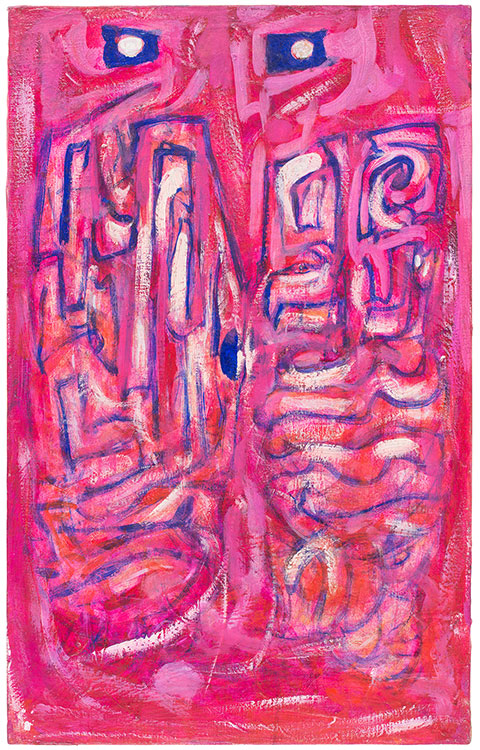
Astre personnages, 1969
Acrylic on canvas
61 x 38 cm – 24 x 15 in.
Signed, titled and dated “M. Raymond ASTRE – PERSONNAGES 1969“ on reverse
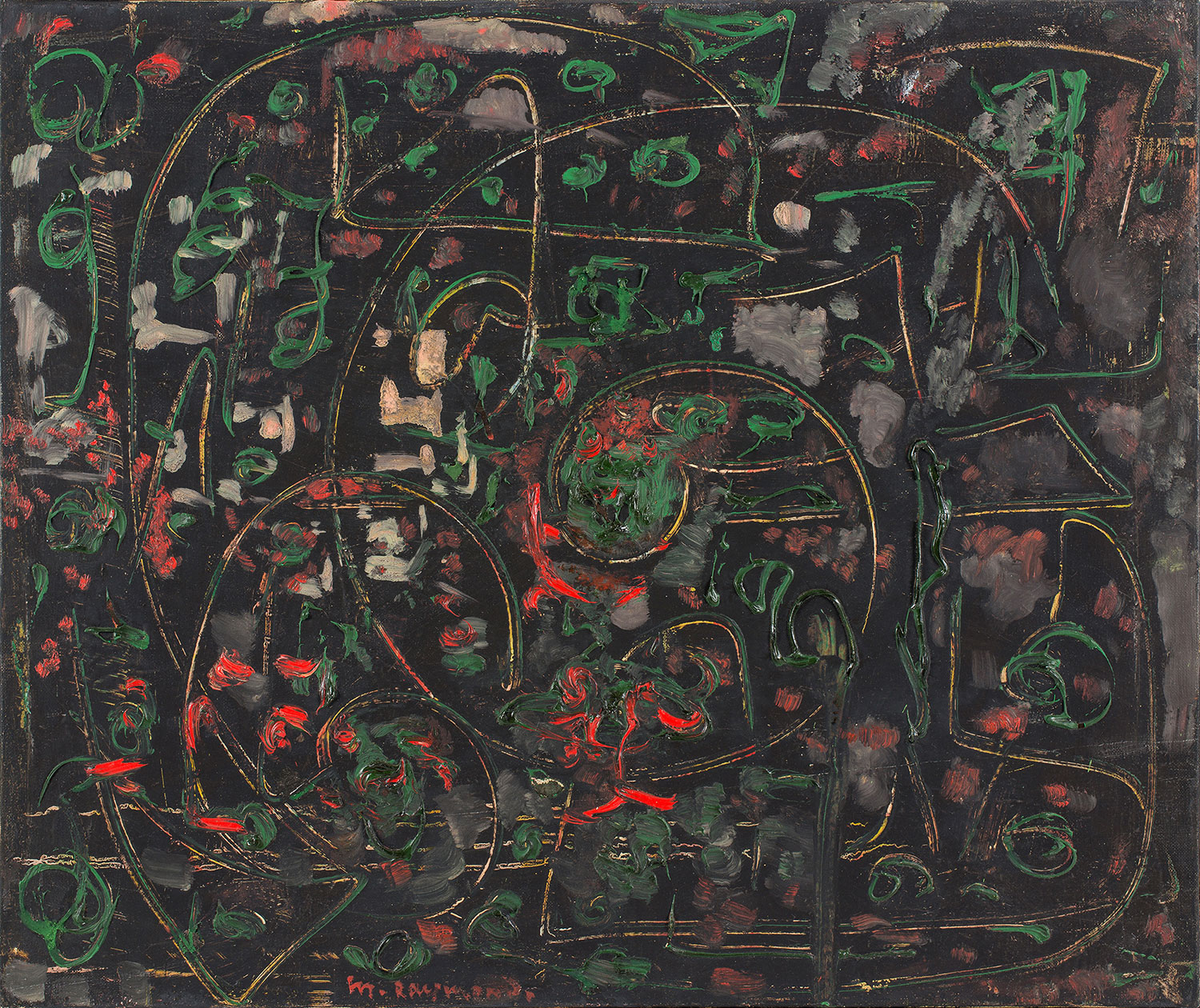
NOCTURNE, 1969
Oil on canvas
46 x 55 cm – 18.1 x 21.7 in.
Signed “M. Raymond“ lower left
Signed, titled and dated “M. Raymond – NOCTURNE – 1969“ on reverse

Effet nocturne, 1969
Acrylic on canvas
38 x 55 cm – 15 x 21.7 in.
Signed, titled and dated “M. Raymond EFFET NOCTURNE 1969“ on reverse

Effet cosmique, 1979
Acrylic on canvas
46 x 55 cm – 18.1 x 21.7 in.
Signed “M. Raymond“ lower right
Signed, titled and dated “M. Raymond EFFET COSMIQUE 1979“ on reverse

Effet cosmique, 1969
Acrylic on canvas
46 x 65 cm – 18.1 x 25.6 in.
Signed, titled and dated “M. Raymond EFFET COSMIQUE 1969“ on reverse

Naissance des étoiles, 1969
Oil on paper laid down on canvas
81 x 130 cm – 31.9 x 51.2 in.
Signed “M. Raymond“ lower right
Signed, titled and dated “M. Raymond NAISSANCE DES ETOILES 1969“ on reverse

Astres, 1969
Acrylic on canvas
55 x 38 cm – 21.7 x 15 in.
Signed, titled and dated “M. Raymond ASTRES 1969“ on reverse

La Rêveuse, 1984
Acrylic on canvas
61 x 50 cm – 24 x 19.7 in.
Signed “M. Raymond“ lower right
Titled, signed and dated “La rêveuse – M. Raymond été 84“ on reverse on the stretcher

Enfermés dans les formes, 1976
Acrylic on canvas
92 x 73 cm – 36.2 x 28.7 in.
Signed, dated and titled “M. Raymond 1976 Enfermés dans les formes“ on reverse

Un monde dans l’espace, 1969
Oil on canvas
96,5 x 162 cm – 38 x 63.8 in.
Signed ‘M. Raymond’ lower right
Signed, titled and dated ‘M. Raymond UN MONDE DANS L’ESPACE 1969’ on reverse
Marie Raymond, « Créer pour voir »
Published in Témoignages pour l’art abstrait, Boulogne, Art d’Aujourd’hui, 1952, p. 241-242
“Life slides into things and light makes it sensible to us. In the light, images are born that are mirrors of the inner self and that place before our eyes, within reach of our senses, a fiction that contains the details and the whole, the interior and the exterior, the desires and the realities, that thoughts are made of, the ideas (the thrust of vitality that has taken shape in the dream), the power that creates the spiritual forms from which the constant process of becoming is nourished.
I glance into this world of dreams and the earth fades away, the horizon fades away, and the beings alone remain, flushed with the rays that the long days passed cast upon their faces, like worlds, individuals that crush and pierce the space with their weight and move around the skies and surrounding air. Everything there seems to play in slow motion so as not to break this atmosphere so light… that it seems unable to support the weight of the bodies. The forms are in suspense, and in time, which grows weary, and catches the clear and vibrant rays of the evening through its forms, the soul of the landscapes mingles with our soul, and contains both anguish and gentleness.”
Marie Raymond, Manuscrit sur l’art
“However vast the movement of humanity and its surroundings may seem, every detail can tell its story, every error confirms the truth.”
COSMIC REVERIES
In the cosmic reveries of the Earth, the world is a human body, a human breath, a human voice. – G. Bachelard
During the daytime, the invisible and ever-present stars travel and their course is connected to an impalpable framework that can nonetheless be sensed. – M.R
From the wings of the night are born the images of the days. – M.R

Notes by Marie Raymond about Gaston Bachelard, undated manuscript. Archives Yves Klein, Paris

Astres bleus, 1969
Oil on canvas
47 x 61 cm – 18.5 x 24 in.
Signed ‘M. Raymond’ lower right
Signed, titled and dated ‘M. Raymond ASTRES BLEUS 1969’ on reverse
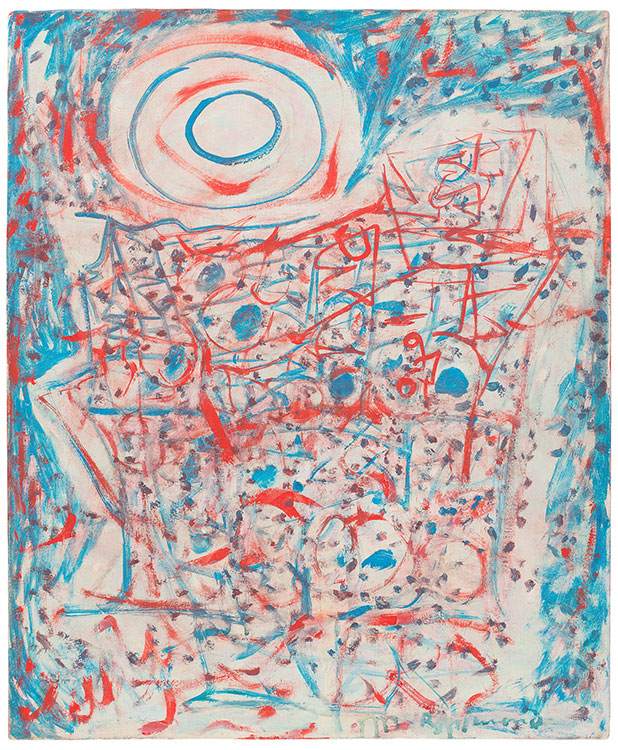
Astres figures, 1969
Acrylic on canvas
61 x 50 cm – 24 x 19.7 in.
Signed “M. Raymond“ lower right
Signed, titled and dated “M. Raymond ASTRES FIGURES 1969“ on reverse

Nuit, 1969
Collage on paper laid down on canvas
194 x 139 cm – 76.4 x 54.7 in.
Signed “M. Raymond“ lower right
Signed, titled and dated “M. Raymond 1969 NUIT“ on reverse
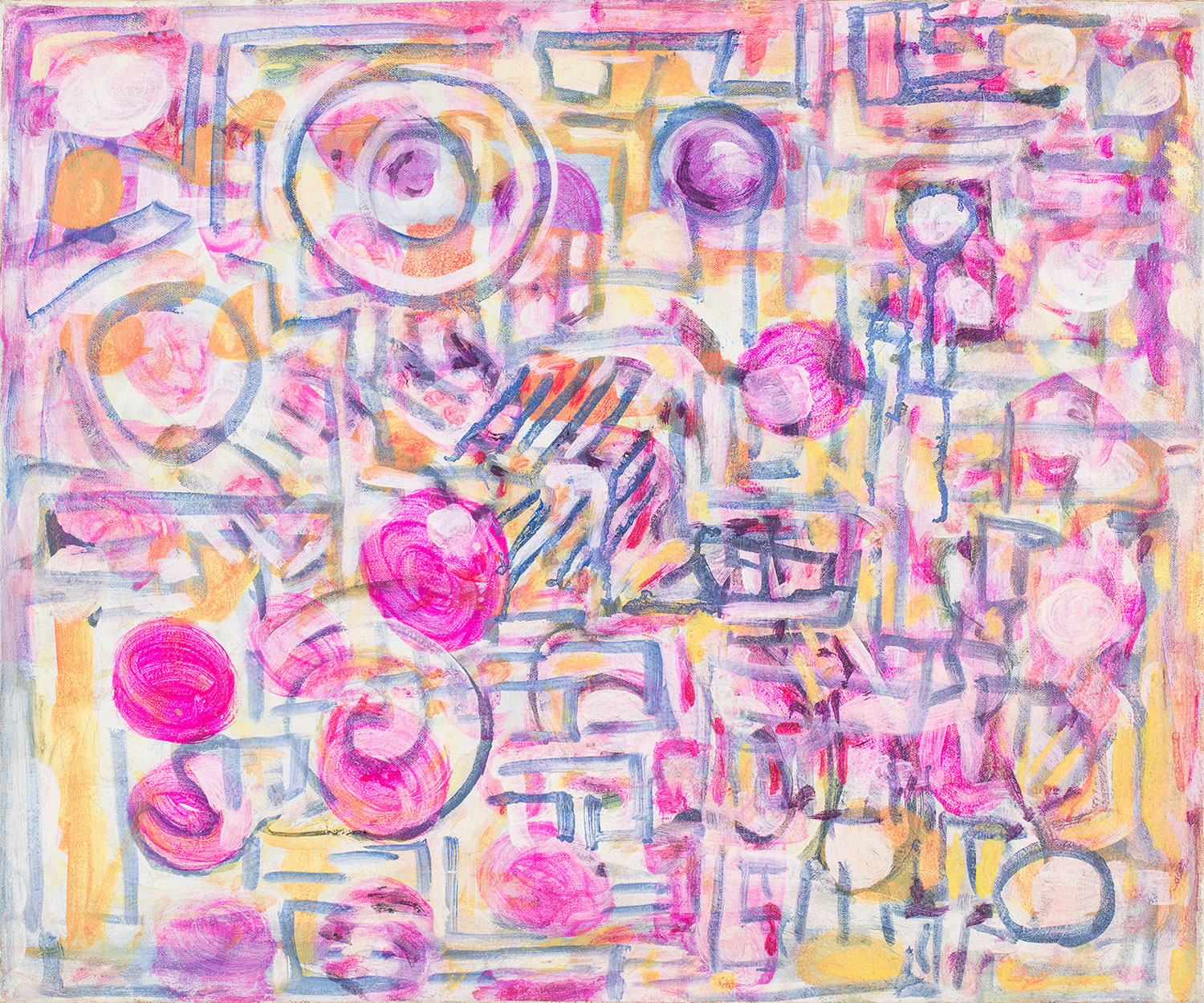
Espace et Astres, 1981
Acrylic on canvas
54,5 x 65,5 cm – 21.5 x 25.8 in.
Signed, titled and dated “M. Raymond 1981 Espace et astres“ on reverse
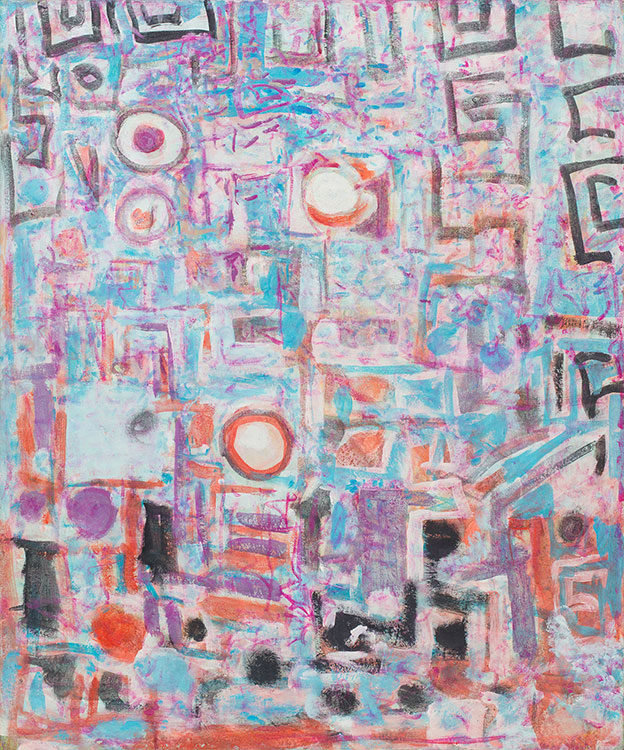
Effet cosmique, 1979
Acrylic on canvas
65 x 54 cm – 25.6 x 21.3 in.
Signed, titled and dated “M. Raymond EFFET COSMIQUE 1979“ on reverse

Grande lumière, 1981
Acrylic on canvas
73,5 x 73,5 cm – 28.9 x 28.9 in.
Signed “M. Raymond“ lower right
Signed, dated and titled “M. Raymond 1981 Grande Lumière“ on reverse
Ce que je voudrais être
Je voudrais être un rayon,
un rayon qui réchauffe,
un simple rayon
qui pénètre curieux, lumineux,
remarqué et aussi souhaité.
Si on me demandait ce que je voudrais être,
inconnu et présent, insaisissable, serein et joyeux,
un rayon qui vient à la rencontre. Du lointain au point juste.
J’aurais franchi l’Espace.
Il me serait facile de fureter,
de découvrir, de caresser, d’être vu.
Jamais saisi, jamais souillé, je serais pur et pourtant je saurais.
Je saurais qu’on m’aime, j’aimerais.
Ce serait bon d’être un rayon. Venu du Soleil même,
mais un rayon tout rond.
Par le même chemin je reviendrais là-haut,
puis, descendrais encore, inlassablement.
La Terre tournerait, bien sûr.
Alors, je chercherais, là-bas, au-delà de l’ombre.
Je sourirais toujours.
Portée par l’air, sondant le Temps,
je pourrais tout connaître.
Et mon identité, pareille à tant d’autres,
serait ici ou là, solitaire et multiple,
à tous les autres uni
et cependant unique
Si j’étais un rayon !
Marie Raymond
Towards becoming
Published in Kroniek van Kunst een Kultuur, 1948
It needs so many millions of beings, so many pairs of eyes, and so many hearts, the world, to examine, down to its most infinitesimal secrets, this impetus for life that pushes it to act. It listens, it watches, it resonates, and it creates. It must adjust, combine, and sort through the chaos to find the things that are in agreement, the seeds that will germinate. The world must feel itself vibrate, be conscious, and build unity out of what is scattered and disparate, to lift the weight of matter that draws it to the ground. It must rely on these “nothings” that will be able to maintain its balance. As such, it rolls through the universe, supported by the ethereal atmosphere that surrounds it. It is a nothing, a hollow, a hole, this vibrant space, the supporting structure of our Earth. This “nothing” is a weight that balances our earthly weight; it is, therefore, strong enough. Space, the void evident between things, between atoms, the fabric of infinity.
Creating means adding weight to the weight of the world; it means making it heavier. And so the world has become heavy with its research, its progress, its discoveries, its peoples. Heavy with its unbalanced past, it lacks air, as it were, to support the weight of its riches. And so we see it trying to appropriate space through science.
A tree grows tall because of both its roots and its branches, and the space it takes in the air, which is larger and more extensive than the space it takes on the ground, widens and opens up, maintaining its balance. For thousands of years, the call of the beyond, the escape of the spirit, and the effort to soar through thought had been enough for our soil. Could it be a lesser effort to force science to seek this support? Could it be that in the interest of compensation, it should reduce the loftiness of its thinking for the vanity of actually being able to soar? Could it be a vain love of life that impels me to think that this effort towards matter, this concentration of thought on earthly things, is only an expansion of the roots of an enlarged evolution?
I will content myself with clarifying the faith that supports me in this certainty. So, perhaps this movement of the art of our time would be justified, a stigma of thoughts aimed at expressing nothings, at creating spaces in which our inner being is in a position to find the rest, the assistance which will ensure its respiration, its ethereal support.

Marie Raymond, around 1982. Archives Yves Klein, Paris
Biographies
Marie Raymond (1908-1989)
MARIE RAYMOND’S YEARS OF STUDIES
Marie Raymond was born on May 4th, 1908 at La Colle-sur-Loup in the south of France, into a Provencal bourgeois family. Her father was a pharmacist and her grandfather was a flower and perfume merchant. Marie Raymond studied in the Blanche de Castille boarding school in Nice. From her adolescence, she practiced yoga, which was still rare in Europe at the time. This unusual interest in yoga and occultism came from her older sister Rose and her husband, a doctor.
Marie Raymond discovered her vocation for painting on visiting the studio of Alexandre Stoppler, a painter based in Cagnes-sur-Mer. He trained the young artist by getting her to paint directly from life. Her memories of the scents, colours and light of the south of France determined the future development of Marie Raymond’s painting. She wrote: “From my early childhood, the memory of playing among mountains of cut roses that my grandfather bought all over the countryside has remained strong.” The south of France attracted artists, many whom visited Cagnessur- Mer to paint. This is how Marie Raymond met the painter Fred Klein whom she married in 1926. She was just eighteen years old.
Two years later, Fred and Marie had a son, Yves Klein. Marie Raymond had the intuition very quickly that her son would be famous: “I was already aware and desired one day to have a son who would be famous. I have always very clearly remembered a phrase from an Opera I heard in Nice. It was Antar, I think, a phrase stayed in my memory that echoed very strongly in me: ‘and one can, with the beat of a wing, fly away to the Sun’, sung of course. And when I consider life, Yves’s momentum, I can’t help finding in it something like the prescience of destiny which was realized, achieved by Yves Klein’s life in its meteoric evolution.”
MARIE RAYMOND’S LIFE BETWEEN PARIS AND THE SOUTH OF FRANCE
The Klein family regularly moved back and forth between Paris and the South, between the desire to live in the art world and economic reality. In Montparnasse, they lived a bohemian life among their friends the artists Jacques Villon, Frantisek Kupka, and especially Piet Mondrian with whom Marie Raymond shared her studio. As she described: “It was like a family, many brothers who found each other and had fun in endless conversations. I still remember chatting to Mondrian, at the Dancing de la Coupole. I wasn’t yet twenty, he was sixty, but he was so happy to be dancing.” Between the south of France and the Netherlands, another painter influenced Marie Raymond: Van Gogh, whose Gardener she first saw, in the form of a coloured print, at Jacques Villon’s home.
Back in Nice in 1932, Marie and Fred became close to Nicolas de Staël and his first wife, Janine Teslar. Marie Raymond attended classes at the Nice school of decorative arts where she met the sculptor Émile Gilioli. She was awarded the commission for a fresco for the pavilion of the Alpes-Maritimes at the International Exposition of 1937.

Marie Raymond in her studio rue d’Assas, Paris, 1965
Archives Yves Klein, Paris

Marie Raymond, vers 1965. Archives Yves Klein, Paris
In 1938, Fred Klein exhibited in Amsterdam and the family took advantage of this to visit the Netherlands. At the start of the war, the family settled in Cagnes-sur-Mer where Marie Raymond started to paint Imaginary Landscapes (1941-1944), inspired by her wanderings in the hinterland; this is when she met Jean Arp and Alberto Magnelli.
At the end of the war, Marie Raymond left her post-Surrealist period and chose abstraction definitively: “gradually, you become internalized, you work. I again sensed the need to express something, but what? The sun still shines! But nothing tangible. How do you recompose life? This is how the first step towards abstract painting is taken.” She made herself a place in the Parisian art scene, which was essentially masculine at the time. Until 1954, Marie Raymond opened her apartment-studio every Monday, creating the “Mondays of Marie Raymond” where the gallerists Colette Allendy, Iris Clert, artists Pierre Soulages, Raymond Hains, François Dufrêne, Jacques de la Villeglé, César, Eugène Ionesco, Jean Tinguely, Hans Hartung, and Nina Kandinsky, as well as the critics Charles Estienne, Pierre Restany, and Georges Boudaille would gather. Pierre Soulages said: “We would go, especially in the evening, for a coffee. We were close, Colette and I, and also our friend Hartung who liked Marie’s painting a lot.”Marie Raymond was also an art critic. She published many articles, especially in the Dutch magazine Kunst en Kultuur for which she was the Paris correspondent from 1939 to 1958.
RECOGNITION FOR THE PAINTER MARIE RAYMOND
In 1945, Marie Raymond participated in her first major exposition at the Salon des Surindépendants. Her work was hung alongside pieces by Hans Hartung, Jean Dewasne, Jean Deyrolle and Gérard Schneider. The following year, Marie Raymond participated in the exhibition La Jeune Peinture Abstraite at the Galerie Denise René. The same year, she exhibited with Serge Poliakoff and Engel Pak at the Centre de Recherches d’Art Abstrait in Paris and then at the first Salon des Réalités Nouvelles. In 1949, she was awarded the Kandinsky Prize with Youla Chapoval and at the Galerie de Beaune an exhibition was held entitled Les gouaches de Marie Raymond. This artist also participated in the first São Paolo Biennale in Brazil.
In 1951, Marie Raymond presented her work with Arp, Doméla, Magnelli, Poliakoff, amongst others at the traveling exhibition Klar Form – 20 Artistes de l’École de Paris organized by Denise René. This exhibition traveled to Copenhagen, Helsinki, Stockholm, Oslo and Liège. In 1952, Marie Raymond exhibited at the Salon de Mai. She interviewed Matisse for the Japanese magazine Mizue. In 1953, the Klein couple exhibited for three days at the Franco-Japanese Institute of Tokyo and at the Bridgestone Museum of Art in Tokyo. Marie Raymond was given a solo show at the Museum of Modern Art of Kamakura.
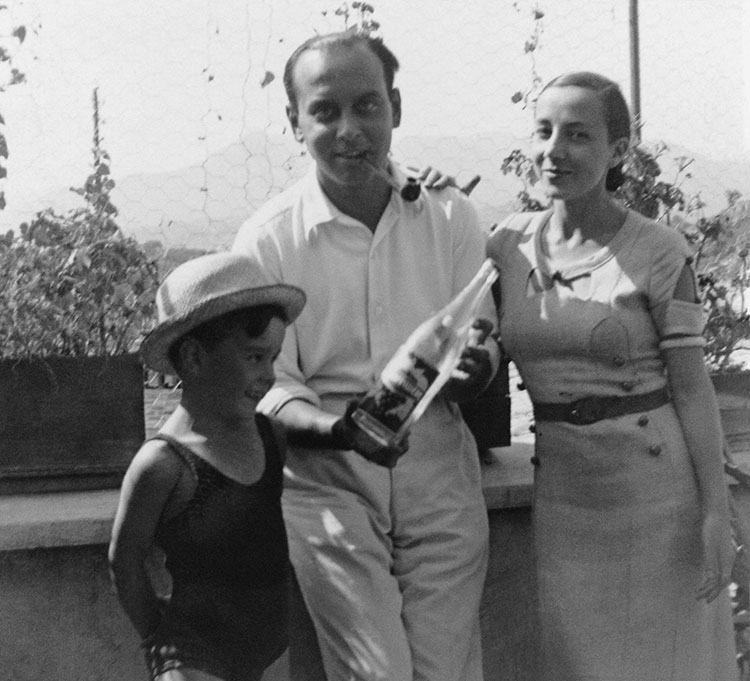
Yves Klein, Fred Klein and Marie Raymond, rue Joseph Laurenti, La Colle-sur-Loup, France, 1930’s. Archives Yves Klein, Paris

“Lundi de Marie Raymond” (Marie Raymond’s Monday), rue d’Assas, Paris, France, October 1954. From left to right: Rose Raymond, Marie Raymond, two unknown men and Fred Klein. Archives Yves Klein, Paris
Fred and Marie participated in 1955 in a travelling exhibition of the Der Kreis (The Circle) Group in Austria and Germany. Marie Raymond then exhibited at the Rio de Janeiro Museum of modern art and at the Lausanne Musée Cantonal. In 1957, an important retrospective called Marie Raymond was held at the Stedelijk Museum in Amsterdam. In 1960, she entered the Marzotto Prize and won a prize for France with the painter Dmitrienko.
At that time, the painter Marie Raymond’s form of abstraction was luminous and lyrical. “For those who haven’t understood the Abstract process, I will try to give a few indications of my working method. After preparing canvases and colours, I would go outside to penetrate myself with the day’s light, walk, even run a little in the Luxembourg gardens near my home, so as to distance myself from the material gesture. For many years, on coming back home, I would focus by reading a few pages from Bergson’s Creative Evolution, which is so full of images, so poetic. With this backbone: having reached a certain internal rhythm, I approached the canvas. A harmony having been revealed, the next stage was tuning and the rhythm of this internal state reached beyond reality and was experienced internally, something beyond the tangible, a chord with ‘the immaterial’ in summary that Yves made light, later on.”
Then came the difficult years for Marie Raymond. The Kleins separated in 1958 and divorced in 1961. The following year, Yves Klein married Rotraut Uecker and died that year of a heart attack at the age of only thirty-four. Marie Raymond said: “Yves had prepared a painting of gold and still had a bouquet of artificial roses separately, taking the bouquet in his hands, he placed it on the painting and asked me the question: “What does this make you think of?” (…) These paintings, he called them “tombs”. Was it a premonition? Because he was in perfect health and very active: This was in the spring, his wife was expecting their child. Who could have foretold that a few months later, he would be carried off so suddenly, in the prime of life, while accomplishing his work.” Marie Raymond’s father also died of a heart attack in 1963.
Marie Raymond’s painting was changed forever by these experiences. The artist found inspiration again in her passion for esotericism and the Cosmos. From 1964, she painted a series of works that she called Abstraction-Figures-Astres. Marie Raymond exhibited at the Galerie Cavalero in Cannes at the Fondation Maeght at Saint Paul-de-Vence and at the Galerie aux Bateliers in Brussels. In 1966, Daniel Templon opened his first gallery, the Galerie Cimaise Bonaparte, with an exhibition of Marie Raymond. In 1972 a major show of her work and of her son, Yves Klein, was organized at the Château-Musée of Cagnes-sur-Mer. In 1988, the Pascal de Sarthe Gallery in San Francisco dedicated a solo exhibition to Marie Raymond. Three times, works by her were shown at the Centre Pompidou in Paris: in 1977, in the exhibition Paris – New York, in 1981, in the exhibition Paris – Paris, Créations en France 1937 – 1957, and finally in 1988 during the exhibition Les années 50. Marie Raymond died the following year in 1989.

Marie Raymond, La Colle-sur-Loup, France, 1977. Photographie André Villers. Archives Yves Klein, Paris / © ADAGP, Paris, 2023

Marie Raymond, La Colle-sur-Loup, France, 1977. Photographie André Villers. Archives Yves Klein, Paris / © ADAGP, Paris, 2023
SELECTED PUBLIC COLLECTIONS
Amsterdam, Stedelijk Museum
Cagnes-sur-Mer, Château-Musée Grimaldi
Nantes, Musée d’Art
Paris, Centre National des Arts Plastiques
Paris, Centre Pompidou
Tokyo, Bridgestone Museum of Art
SELECTED EXHBITIONS
12e Salon des Indépendants, Paris, 1945
Galerie Denise René, Paris, 1946, 1947, 1948, 1949, 1953, 1975, 1988
Marie Raymond, Engel Pak, Poliakoff, Centre de Recherches d’Art Abstrait, Paris, 1946
Salon des Réalités Nouvelles, Paris, 1946, 1947, 1948, 1958, 1962, 1968
Prise de terres, Peintres et sculpteur de l’objectivité, Galerie Breteau, Paris, 1948
Galerie Colette Allendy, Paris, 1949, 1950, 1956
Galerie de Beaune, Paris, 1949, 1950, 1951
Salon de Mai, Paris, 1952, 1961
Marie Raymond Fred Klein, Bridgestone Gallery, Tokyo, 1953
Marie Raymond, Musée d’Art Moderne, Kamakura, 1953
Marie Raymond Garbell Hillaireau Lyrisme de la couleur, Galerie Art Vivant, Paris, 1953
Marie Raymond, Galerie du Théâtre de Poche, Brussels, 1954
Du futurisme à l’art abstrait, Musée cantonal des Beaux-Arts, Lausanne, 1955
Marie Raymond, Stedelijk Museum, Amsterdam, 1957
II Micro-salon di Iris Clert di Iris Clert di Parigi in esclusività per l’Italia, Galerie Apollinaire, Milan, 1957
Galerie Iris Clert, Paris, 1957, 1958
Galerie La Tartaruga, Rome, 1957
Galerie Europe, Brussels, 1959
Marie Raymond, Galerie Cavaléro, Cannes, 1963
Galerie Cimaise Bonaparte, Paris, 1966
Marie Raymond peintures – Dessins, Galerie aux Bateliers, Bruxelles, 1966
Marie Raymond Yves Klein, Château Musée, Cagnes-sur-Mer, 1972
1ère Biennale française de la tapisserie en hommage à Jean Lurçat, Palais de l’Europe, Menton, 1975
IIème Biennale Française de la Tapisserie en hommage à Le Corbusier, Palais de Juan-les-Pins, Antibes, 1977
Centre Georges-Pompidou, Paris, 1977, 1981, 1988
Charles Estienne et l’art à Paris 1945-1966, Centre National des Arts Plastiques, Paris, 1984
La part des femmes dans l’art contemporain, Vitry-sur-Seine, 1984
Aspects de l’art en France de 1950 à 1980, Musée Ingres, Montauban, 1985
Hommage à Iris Clert, Acropolis, Nice, 1986
L’Art en Europe – Les années décisives 1945-1953, Musée d’Art moderne, Saint-Étienne, 1987
Abstraction expressions – confrontations 1950-1970, Galerie Bernard Davignon, Paris, 1988
Aspects de l’Art abstrait des années 1950, exposition collective itinérante : Foyer de l’Opéra, Lille ; Vieille église Saint-Vincent, Bordeaux ; Auditorium Maurice Ravel, Lyon ; Chapelle Saint-Louis, Rouen ; Hôtel-Dieu Saint Jacques, Toulouse ; Musée Hébert, Grenoble ; Palais de la Bourse, Nantes ; Casino Municipal, Royat ; Mairie de Nancy, 1988-1989
Pascal de Sarthe Gallery, San Francisco, 1988, 1991
Marie Raymond, Rétrospective 1937-1987, Musée d’Art moderne et d’Art contemporain, Nice, 1993
L’École de Paris – 1945-1964, Musée national d’histoire et d’art, Luxembourg, 1998
Marie Raymond – Yves Klein, Musée des beaux-arts, Angers, 2004
Marie Raymond – Yves Klein, Musée des beaux-arts, Carcassonne, 2006
Marie Raymond – Yves Klein, Museum Ludwig, Koblenz, 2006
Marie Raymond – Yves Klein, LAAC Dunkerque, Dunkirk, 2007
Marie Raymond – Yves Klein Herencias, Circulo de bellas arte, Madrid, 2010
Marie Raymond – Vers la Lumière, Galerie Diane de Polignac, Paris, 2019
Marie Raymond, Le Royaume invisible, Abstraction-Figures-Astres, Galerie Diane de Polignac, Paris, 2023
SELECTED BIBLIOGRAPHY
Marie Raymond, « Abstraction, Lyrisme, Vérité… », Kroniek Van Kunst En Kultuur, n°15, June 1939
Charles Estienne, Léon Degand, Pour ou contre l’art abstrait, Paris, Le Courneur, 1947
Marie Raymond, « Les Origines de l’Art abstrait », Kroniek Van Kunst En Kultuur, n°9, September 1949
Marie Raymond, « Soulages à la Galerie Lydia Conti, Vieira da Silva à la Galerie Pierre », Kroniek Van Kunst En Kultuur, n°11, November 1949
Charles Estienne, L’art abstrait est-il un académisme?, Paris, Éditions de Beaune, 1950
Michel Ragon, Expression et non-figuration, Paris, Éditions de la Revue, 1950
Pierre Francastel, Peinture et société, Lyon, Éditions Audin, 1951
Léon Degand, Julien Alvard, Roger Van Gindertael, Témoignage pour l’art abstrait, Paris, Art d’Aujourd’hui, n°1, 1952
Pierre Courthion, Peinture d’aujourd’hui, Geneva, Pierre Caillier, 1952
Marie Raymond, « Interview avec Henri Matisse », Mizue, Tokyo, n°571, March 1953
Robert Lebel, Pierre Descargues, Roger Van Gindertael, Premier bilan de l’art actuel, Paris, Le Soleil Noir, 1953
Renée Huyghe, Dialogue avec le visible, Paris, Flammarion, 1955
Michel Ragon, L’aventure de l’art abstrait, Paris, Robert Laffont, 1956
Marcel Brion, L’abstraction, Paris, Aimery Somogy, 1956
Jean Bouret, L’art abstrait : ses origines, ses luttes, sa présence, Paris, Club français du livre, 1957
Michel Seuphor, Dictionnaire de la peinture abstraite, Paris, Fernand Hazan, 1957
Bernard Dorival, Les peintres du XXe siècle, Paris, Tisné, 1957
Gabrielle Buffet-Picabia, Aires abstraites, Geneva, Pierre Caillier, 1957
Michel Ragon, La peinture actuelle, Paris, Berger- Levrault, 1959
Pierre Restany, Lyrisme et abstraction, Milan, Apollinaire, 1960
Jean Cassou, Panorama des arts plastiques contemporains, Paris, Gallimard, 1960
Michel Ragon, Naissance d’un art nouveau – Tendances et techniques de l’art, Paris, Albin Michel, 1963
Raymond Bayer, Entretiens sur l’art abstrait, Geneva, Pierre Caillier, 1964
Michel Seuphor, La peinture abstraite, sa genèse, son expansion, Paris, Flammarion, 1964
Herbert Read, Histoire de la peinture moderne, Paris, Somogy, 1966
Dora Vallier, L’art abstrait, Paris, Le Livre de Poche, 1967
Michel Ragon, Michel Seuphor, L’art abstrait 1939- 1970, Paris, Galerie Maeght, vol. III, 1973
Marie Raymond, « Au Grand-Palais, la FIAC 79 – Les Fantasmes de Picasso », + – O, n°29, April 1980
Michel Ragon, 25 ans d’art vivant 1944-1969, Paris, Galilée, 1986
Marie Raymond Forty Years of Abstract Painting, San Francisco, Pascal de Sarthe Gallery, 1988
Geneviève Bonnefoi, Les années fertiles 1940-1960, Paris, Mouvements, 1988
Jean-Luc Daval, Histoire de la peinture abstraite, Paris, Fernand Hazan, 1988
Georges Boudaille, Patrick Javault, L’art abstrait, Paris, Nouvelles Éditions françaises, 1990
Marie Raymond Rétrospective 1937-1987, Nice, MAMAC, 1993
Lydia Harambourg, L’École de Paris 1945-1965 Dictionnaire des peintres, Neuchâtel, Ides et Calendes, 1993
Robert Fleck, Marie Raymond – Yves Klein, Angers, Expressions contemporaines, 2004
Robert Fleck, Marie Raymond / Yves Klein, Coblence, Kerber Verlag, Bielefeld / Ludwig Museum, 2006
Marie Raymond – Yves Klein Herencias, Madrid, Círculo de bellas arte, 2009
Marie Raymond – Vers la lumière, Paris, Galerie Diane de Polignac, 2019
Lucia Pesapane, Marie Raymond, Le Royaume invisible, Abstraction-Figures-Astres, Paris, Galerie Diane de Polignac, 2023

Marie Raymond, La Colle-sur-Loup, France, 1977. Photographie André Villers. Archives Yves Klein, Paris / © ADAGP, Paris, 2023

Marie Raymond, La Colle-sur-Loup, France, 1965. Archives Yves Klein, Paris
The Marie Raymond’s artworks presented during this exhibition and reproduced in this catalog come from the Yves AMU Klein collection. The Diane de Polignac Gallery thanks Mr. Yves AMU Klein for making this beautiful project of exhibition and publication possible. The Diane de Polignac Gallery would also like to thank Mr. François Roulin of the Yves Klein Archives for his collaboration and invaluable assistance.
Marie Raymond
Le Royaume invisible
Abstraction – Figures – Astres
Exhibition from March 9 to April 22, 2023
Diane de Polignac Gallery
2 bis, rue de Gribeauval, Paris
www.dianedepolignac.com
Translation: Lucy Johnston
Graphic design: Diane de Polignac Gallery
ISBN: 978-2-9584349-2-2
© Diane de Polignac Gallery, Paris, March 2023
Texts are author’s property
© ADAGP, Paris 2023 for the works of Marie Raymond
Reserved rights
